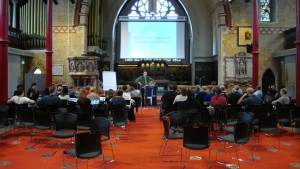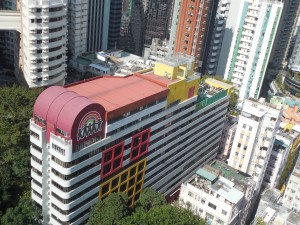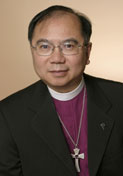When a bishop is away
Trips contribute to church overseas and at home
By Bishop Patrick Yu
From time to time you will read in The Anglican that your bishop is away from the diocese. You may wonder, even aloud, “Why are bishops away so much and what do they do?” I am writing this in a hotel in Liverpool. I thought it might be a useful starting point to give an account of this part of episcopal ministry.
I am writing after the final of four meetings of the Inter-Diocesan Learning Community of the Church of England. The project is funded by the Church Commissioners to help senior diocesan leaders undertake intentional change towards more effective and missional ministry. Each leadership team is subjected to an intense process that asks, “What is?” (For example, what is the current situation in the diocese? What are the issues we feel are most important?) Then we are asked, “What can be?” This is when the teams imagine ways to improve the present situation. Finally, we are asked, “What will be?” The meeting concludes with each team sharing its plan, from its general direction to concrete implementation, with names of individuals responsible for each action. Nine months later, we report to the other dioceses on whether and how we have acted on our plans. Through reporting, we are gently held accountable to our peers. Toronto is the only diocese outside the Church of England invited to this process. Besides me as bishop, our team consists of our diocese’s canon missioner, our director of Congregational Development, and the Archdeacon of York, who is also our chief administrative officer. We are the smallest team because of the distance we must travel.
Looking back over the last three years of our involvement, the exercise has been fruitful. Our particular focus has been on every level of leadership. The exercise gave impetus to the recruitment and training of congregational leaders. To give just two examples, every postulant now participates in a course in mission and evangelism before their ordination. The diocese is also close to deploying a few trained, intentional interim priests for a longer period of time (around two years) in those parishes that need special care.
By engaging with other dioceses, we found support from people and places that struggle with similar issues and work toward similar goals. We liked the process so much that we imported it back to Canada. The other dioceses involved here are Edmonton, Nova Scotia and Prince Edward Island, and Algoma, and we meet in Toronto. Our diocese’s team for the Canadian process is bigger and younger. Those of us in the original team who went to Liverpool are busy handing over to the new team.
On every trip, additional benefits accrued before and after the official meeting. For example, we came to know Stephen Cottrell, the bishop of Chelmsford in England. We invited him to lead our clergy conference last year. His talks, which are on our diocese’s You Tube channel, were widely acclaimed.

There is not one trip in which I do not bring back some new resource, connection or idea. This time I got to examine an alternative to our current way of clergy formation. I had heard about St. Mellitus College for some time but finally visited it with Canon Susan Bell on our way to Liverpool. The college is a joint venture by the dioceses of London and Chelmsford, and Holy Trinity, Brompton. It provides a parish-based approach to theological education. Rather than taking candidates away from the parish to train, the college insists that the student stay in the parish and use it for formation. The sponsoring parish employs the student half-time and sends her or him to school the other half. The academic curriculum is rigorous and is accredited through the universities of Durham and Middlesex. While the student’s formation is based in the parish, he or she also experiences college life, which intentionally helps them to appreciate and respect all the streams within Anglicanism without trying to put them into a particular mold. Started only seven years ago, the college already has 157 students in the ordination stream – that’s a significant percentage of the prospective ordinands in the Church of England. The college has students in other streams as well, such as youth ministry and church planting. Susan and I look forward to reporting to the Diocesan Leadership Team, and I will ask for some time in the House of Bishops to present this exciting concept of theological education.

I also had the privilege earlier this year of teaching in the Anglican seminary in Hong Kong. One tangible benefit of this is that I brought back ministry resources in Cantonese and Mandarin for our Chinese churches and New Hope Mandarin ministries here in the Diocese of Toronto. I also brought back observations and reflections from having experienced the church operating in another setting. In my report to our Diocesan Leadership Team, I pointed out the willingness of the Hong Kong government and the church to take risks investing in the future, something that is in contrast with our own often cautious stance. For example, the St. James settlement building is wholly dedicated to social service and continuing education, and its exemplary service attracts volunteers and financial support from society at large. There is more: the photo was taken from the roof of St. James Church, which occupies both the bottom floors and the top floor of a brand new building, with a church-sponsored primary school in between. The government paid for the part which housed the school, but the church had to raise the funds for their own floors. The vicar spoke of the cliff-hanging years of fundraising, which stretched her faith and that of her parishioners.
But learning is not all one way. Through interaction with others, I have come to appreciate the strength of the Diocese of Toronto. God has been very gracious in guiding us into policies and practices that have been widely acclaimed, somewhat to our surprise and much to our delight. When you visit our Diocesan Center in Toronto, you can look into the cupboard opposite the reception desk and find a yellow “Lambanana,” which is the trophy our team took home last year for the most innovative idea! Our diocese is unique and we must weigh every new idea against what we already do well. We have learned not to chase every new idea, or simply copy what other people do, but to use the insights we have gained to embark on the hard work of choosing and developing our own strategies.
Obviously, the extent of the bishops’ involvement as a proportion of our diocesan responsibilities is subject to discussion, and the College of Bishops does engage in this discussion. (Actually, with today’s communication, the concept of “away” is blurred and all the bishops, including myself, deal with crisis situations and correspondence as much as we can.) So next time you find that your bishop is away, be patient and realize that she or he is likely contributing to the wider church as well as bringing benefits, both tangible and intangible, to our common mission in the Diocese of Toronto.
Bishop Patrick Yu is the area bishop of York-Scarborough.
